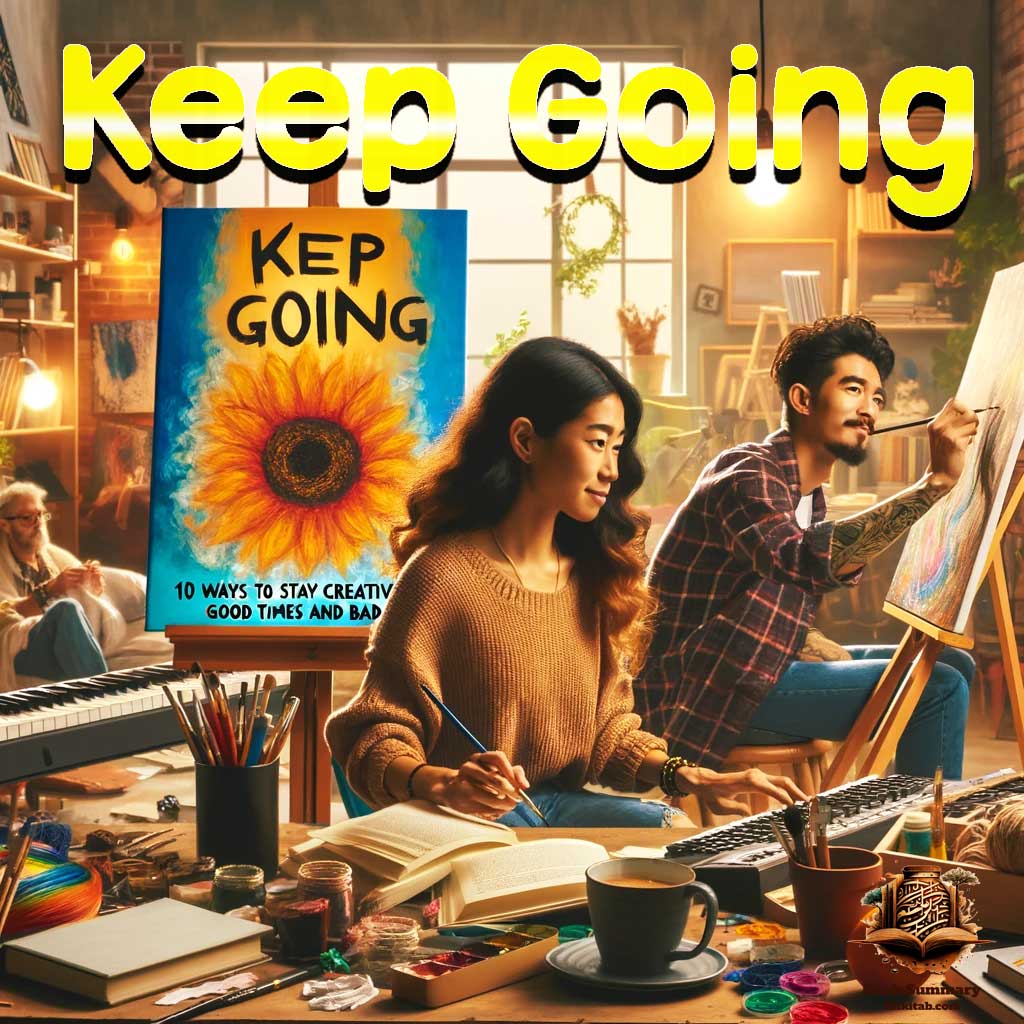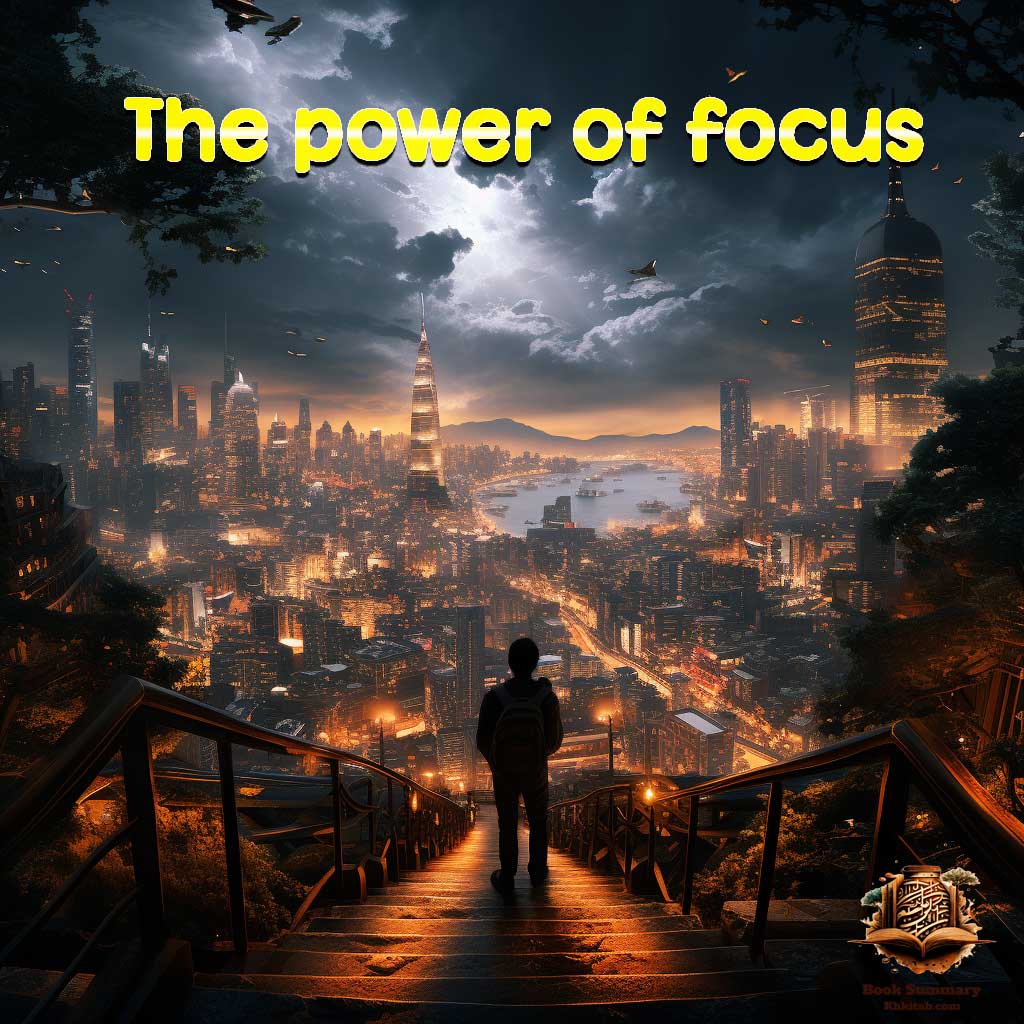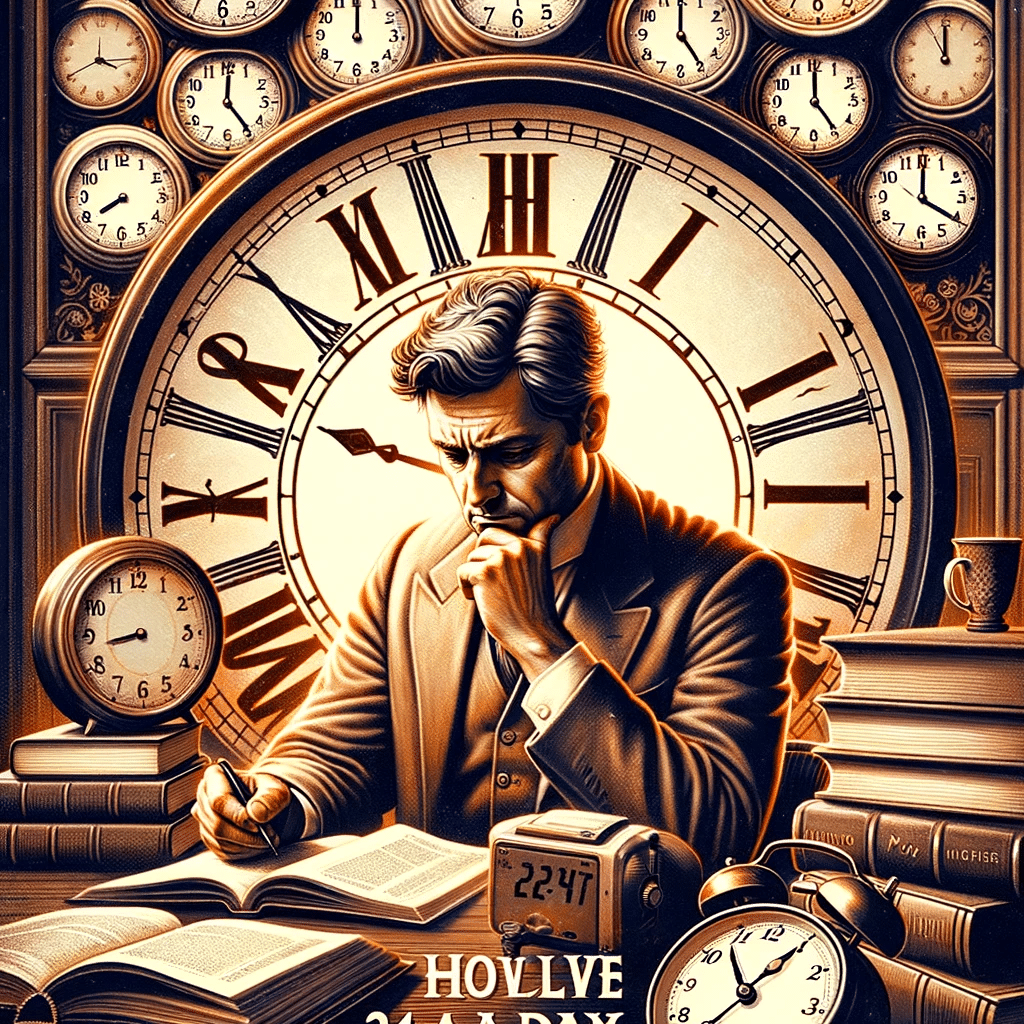Keep Going: 10 Ways to Stay Creative in Good Times and Bad Book Summary

In our rapidly changing and challenge-filled world, many people are seeking ways to maintain their creativity and keep renewing themselves in their daily lives. “Keep Going: 10 Ways to Stay Creative in Good Times and Bad” by Austin Kleon offers an insightful and inspiring look at how to achieve this.
Austin Kleon, with his personal experiences and profound insights, serves as a guide and inspiration for many who strive to keep the flame of creativity burning in their lives, whether they are artists, writers, musicians, or even entrepreneurs. In this book, Kleon presents a collection of practical tips and strategies that can be applied in various times and circumstances.
The book begins by emphasizing the importance of developing a balanced daily routine that creates a conducive environment for creativity. Kleon stresses that the routine should not be a constraint but rather a support and catalyst for creative thinking. He also delves into the significance of play and experimentation as a means to open new doors to creativity, focusing on the idea that art is not just a final product but a continuous journey of discovery and renewal.
إقرأ أيضا:The Gifts of Imperfection: Embracing Self in a Flawed WorldOne of the standout pieces of advice in the book is the importance of rest and taking regular breaks to rejuvenate energy and maintain mental health, as well as the emphasis on the importance of movement and perseverance even in the toughest conditions. Kleon also highlights the importance of community and connecting with others as a source of inspiration and support.
“Keep Going” is not just a book offering tips for creativity, but it is an invitation to understand creativity as a lifestyle and to develop personal strategies that help cope with challenges and creatively seize opportunities. This book is a valuable guide for anyone seeking to continue on their creative journey, regardless of the surrounding circumstances.
How Does Establishing a Daily Routine Enhance Creativity and Productivity According to ‘Keep Going’ by Austin Kleon?
In “Keep Going: 10 Ways to Stay Creative in Good Times and Bad,” Austin Kleon delves deeply into the concept of establishing a daily routine as a cornerstone for fostering creativity and productivity. This topic, crucial in the book, explores how a well-structured routine can become a catalyst for creative thinking and a stable platform for consistent artistic output.
Kleon starts by debunking the myth that creativity is solely about chaotic bursts of inspiration. Instead, he proposes that a regular routine acts as a foundation, offering stability in the unpredictable world of creative work. He illustrates this with examples from famous artists and writers who adhered to strict daily schedules, thereby channeling their creative energies more effectively.
The book emphasizes that a routine should not be rigid or stifling. Instead, it should be tailored to the individual’s personal rhythms and life circumstances. Kleon suggests that the key is in finding a balance – a routine that allows enough flexibility for spontaneous creativity, yet provides sufficient structure to prevent procrastination and aimlessness.
Kleon also touches upon the psychological benefits of a routine. He notes that having a set pattern of work can alleviate anxiety and mental clutter, allowing the mind to focus more freely on the creative task at hand. This structured approach to work and life helps in setting clear boundaries, thus enabling creative professionals to separate their work from their personal life, leading to a healthier work-life balance.
In “Keep Going,” Kleon also offers practical advice on how to establish and maintain a routine. He encourages starting with small, manageable habits and gradually building upon them. He stresses the importance of consistency over intensity, suggesting that it’s more beneficial to work steadily and regularly rather than in unpredictable, intense bursts.
The overarching message of this section of the book is that a well-thought-out daily routine is not a constraint on creativity. Rather, it’s a tool that provides the discipline and framework within which creativity can flourish. Kleon’s approach in “Keep Going” is not just theoretical; it’s filled with actionable advice, making it immensely valuable for anyone looking to enhance their creative productivity through the establishment of a daily routine.
In summary, “Keep Going” redefines the role of routine in the creative process, presenting it as an essential element that supports and nurtures the creative mind, enabling artists and creators to produce their best work consistently and effectively.
How Does ‘Keep Going’ Advocate for Playfulness and Experimentation in Creativity?
In “Keep Going: 10 Ways to Stay Creative in Good Times and Bad,” author Austin Kleon presents a compelling argument for the role of play and experimentation in the creative process. This topic is central to the book’s message, emphasizing that creativity isn’t just about producing work but also about the journey of exploration and discovery that comes through playful experimentation.
Kleon begins this discussion by challenging the conventional view of play as something trivial or exclusive to childhood. He instead portrays play as a fundamental aspect of creativity, essential for adults as much as for children. Through various anecdotes and examples, Kleon illustrates how many successful creatives have integrated play into their routines, leading to breakthroughs and innovative ideas.
One of the key points Kleon makes is that playfulness opens the mind to new possibilities. When we allow ourselves to play, we break free from the constraints of usual thinking patterns. This mental liberation is crucial for creative breakthroughs, as it leads to unexpected connections and ideas. Kleon uses stories from famous artists and scientists who made significant discoveries while engaging in play-like activities, underscoring how these moments of light-hearted exploration can yield profound results.
Furthermore, Kleon argues that experimentation, a form of play, is vital for growth and development in any creative field. He encourages readers to try new things without the fear of failure, suggesting that the act of experimenting itself is more important than the final outcome. This perspective helps creatives to embrace failure as part of the learning process, allowing them to take risks and push boundaries in their work.
In “Keep Going,” Kleon also addresses the importance of creating a safe space for play and experimentation. He suggests practical ways to cultivate such an environment, like setting aside specific times for unstructured exploration or designating a physical space dedicated to playful activities. This approach helps in nurturing a mindset where creativity can flourish, free from the pressures of judgment and expectation.
In summary, “Keep Going” presents play and experimentation not as mere distractions, but as fundamental components of the creative process. Kleon’s insights provide a refreshing perspective on how embracing a playful attitude and a willingness to experiment can lead to greater creativity, innovation, and ultimately, personal and professional fulfillment in the creative journey.
Marketing: A Love Story – Building Strong Customer Relationships for Success
How Does ‘Keep Going’ Emphasize Creating Art for Personal Satisfaction Over External Validation?
In “Keep Going: 10 Ways to Stay Creative in Good Times and Bad,” Austin Kleon devotes a significant portion of the book to the concept of “Art for Art’s Sake.” This principle, central to his message, is about creating art for personal satisfaction and expression, rather than seeking external validation or commercial success. Kleon’s approach here is refreshingly human and relatable, as he delves into why this perspective is crucial for maintaining a fulfilling and sustainable creative practice.
Kleon begins by addressing the common pressure artists face to measure their success through external benchmarks, like sales, acclaim, or social media popularity. He argues that this external-focused mindset can lead to creative burnout and a loss of the original passion that drives artistic work. Instead, Kleon advocates for a shift back to the roots of why people create art in the first place: for the sheer joy and expression it provides.
Throughout this section, Kleon shares stories and anecdotes of artists who found profound satisfaction in their work by focusing on their personal vision and voice, rather than conforming to external expectations. These narratives serve as powerful examples of how artists can stay true to their own style and interests, even in the face of commercial pressures or trends.
Furthermore, Kleon discusses how creating art for oneself can be a deeply therapeutic and introspective process. He encourages artists to view their practice as a personal journey, one where the act of creation is its own reward. This perspective allows artists to explore their thoughts, emotions, and experiences freely, leading to more authentic and meaningful work.
Kleon also tackles the practical aspects of this approach. He suggests balancing personal artistic pursuits with commercial work, if necessary, to maintain financial stability. However, he stresses the importance of carving out time and space for personal projects that are driven purely by the artist’s own interests and passions.
In essence, “Keep Going” promotes the idea that art should primarily be a form of personal expression and satisfaction. This focus on “Art for Art’s Sake” is a call for artists to rediscover the joy in their work, free from the constraints of external validation. Kleon’s insights in this section provide valuable guidance for artists seeking to maintain their creative integrity and find fulfillment in their artistic journey.
How Does ‘Keep Going’ Emphasize the Importance of Rest for Creative Recharge and Mental Health?
In “Keep Going: 10 Ways to Stay Creative in Good Times and Bad,” Austin Kleon dedicates a vital section to discussing the Importance of Rest, underlining it as crucial for both creative rejuvenation and mental health. This part of the book speaks directly to the often-overlooked aspect of creative work: the need for downtime and disengagement from the constant cycle of production.
Kleon starts by challenging the glorified ‘always-on’ work ethic prevalent in many creative fields. He points out that constant work without sufficient rest leads to burnout, a reduction in the quality of creative output, and can severely impact mental health. Kleon uses anecdotes and examples from well-known creatives who have suffered from burnout, illustrating how even the most successful artists need to prioritize rest.
One of the central themes in this section is the concept of rest as an active part of the creative process, not just a passive break from work. Kleon argues that taking time to rest is when the subconscious mind can process and synthesize ideas, often leading to breakthroughs and new insights. He suggests that rest should be scheduled and respected just as much as work time, emphasizing its role in maintaining a sustainable creative rhythm.
Kleon also addresses the guilt and anxiety that creatives often feel when they take a break, reassuring readers that stepping back is not only okay but necessary. He offers practical advice on how to integrate rest into one’s daily routine, such as establishing regular sleep patterns, taking short breaks during work hours, and setting aside longer periods for complete disengagement from work.
Furthermore, Kleon discusses how rest is not just about physical relaxation but also mental and emotional rejuvenation. He encourages practices such as mindfulness, meditation, or engaging in non-work-related hobbies as ways to reset the mind and keep the creative juices flowing.
In summary, “Keep Going” presents rest as an indispensable element of the creative lifecycle. By highlighting the importance of taking breaks and resting, Kleon offers a holistic view of creativity, one that values the health and well-being of the artist as much as their artistic output. This perspective is invaluable for anyone in creative fields, offering a balanced approach to managing work and rest for long-term creative vitality and mental health.
How Does ‘Keep Going’ Guide Creatives in Overcoming Obstacles and Persisting Through Challenges?
In “Keep Going: 10 Ways to Stay Creative in Good Times and Bad,” Austin Kleon delves into the vital topic of Perseverance Through Challenges, providing strategies for artists and creatives to continue their work despite facing obstacles and creative blocks. This section of the book is particularly resonant, as it addresses a common struggle in the creative process: how to maintain momentum in the face of adversity.
Kleon begins by acknowledging that creative work is inherently filled with ups and downs. He normalizes the experience of facing obstacles, whether they are external, such as criticism or market changes, or internal, like self-doubt or burnout. Kleon’s approach is human and empathetic, offering reassurance to creatives that they are not alone in these struggles.
One of the core strategies Kleon emphasizes is the importance of establishing a resilient mindset. He encourages creatives to view challenges not as insurmountable barriers but as opportunities for growth and learning. This shift in perspective can transform the way artists approach problems, making them less daunting and more manageable.
Kleon also addresses the concept of creative blocks, offering practical advice on how to navigate through them. He suggests techniques such as changing the work environment, experimenting with different mediums, or simply taking a step back to gain a fresh perspective. He underscores the importance of flexibility and adaptability in the creative process, highlighting how sometimes a detour can lead to unexpected and rewarding paths.
Moreover, Kleon shares inspiring stories and examples from famous artists and writers who persevered through difficult times. These narratives not only serve as motivation but also illustrate how challenges can be catalysts for innovation and creativity. He shows that many breakthroughs and masterpieces have been born out of periods of struggle, reinforcing the idea that perseverance is key to creative success.
Additionally, Kleon emphasizes the role of community and support networks in helping creatives overcome challenges. He encourages seeking feedback, joining creative communities, and sharing experiences with peers, as these interactions can provide new insights, encouragement, and a sense of solidarity.
In summary, “Keep Going” offers a wealth of guidance and inspiration for creatives facing challenges. By focusing on perseverance and resilience, Kleon provides practical strategies and encouraging stories that highlight the importance of pushing through obstacles. This aspect of the book is a crucial resource for anyone in the creative field, offering valuable lessons on how to persist and thrive even in the most challenging times.
How Does ‘Keep Going’ Advocate for Maintaining Curiosity to Fuel Creativity?
In “Keep Going: 10 Ways to Stay Creative in Good Times and Bad,” Austin Kleon emphasizes the significance of maintaining a mindset of continuous learning and curiosity as a key driver of creativity. This aspect of the book delves into the concept that curiosity is not just an innate trait, but a cultivated mindset that can significantly enhance the creative process.
Kleon starts by challenging the notion that curiosity diminishes with age. He argues that while children are naturally curious, adults often lose this sense of wonder due to societal pressures or the monotony of daily routines. However, Kleon asserts that reigniting this curiosity is essential for creative growth and can be achieved through various practices.
One of the primary ways Kleon suggests to maintain curiosity is through constant learning and exploration. He encourages readers to step out of their comfort zones and engage with new ideas, subjects, and experiences. This approach, he argues, opens up a world of possibilities and feeds the creative mind with fresh inspiration.
Kleon also highlights the importance of asking questions and seeking understanding, rather than simply accepting things at face value. He shares stories of renowned creatives who were known for their inquisitive nature, demonstrating how their curiosity led to groundbreaking work and innovation. These narratives serve as powerful examples of how questioning the status quo can lead to creative breakthroughs.
Moreover, Kleon discusses the role of hobbies and side projects in fostering curiosity. He suggests that engaging in activities unrelated to one’s primary work can be a powerful way to stimulate the mind and discover new interests. These pursuits, Kleon notes, often provide unexpected insights and ideas that can be applied back to one’s main creative work.
Additionally, Kleon touches on the importance of creating an environment that nurtures curiosity. He advises setting up a workspace that encourages exploration and experimentation, and surrounding oneself with materials and resources that spark interest and imagination.
In summary, “Keep Going” presents maintaining curiosity as a vital component of the creative process. By advocating for continuous learning, exploration, and questioning, Kleon provides a roadmap for creatives to keep their minds active and open, ensuring a steady flow of fresh ideas and perspectives. This focus on curiosity is a critical message for anyone looking to sustain their creativity and stay inspired, regardless of their field or experience level.
How Does ‘Keep Going’ Advocate for Hands-On Work as a Stimulus for Creative Thinking?
In “Keep Going: 10 Ways to Stay Creative in Good Times and Bad,” Austin Kleon explores the value of hands-on work and physical engagement as powerful stimuli for creative thinking. This section of the book delves into how manual activities, distinct from digital work, can unlock new levels of creativity and provide a refreshing perspective on the creative process.
Kleon starts by discussing the modern dilemma where much of our work, especially in creative fields, has become increasingly digital and screen-based. While acknowledging the benefits of digital tools, he points out that they can sometimes disconnect us from the tactile experience of creating with our hands. Kleon argues that this tactile experience is crucial for a deeper connection with our work and can lead to enhanced creativity.
He advocates for incorporating more physical and manual activities into the creative routine. Kleon shares examples of artists and writers who engage in activities like drawing, sculpting, gardening, or even simple tasks like organizing a workspace, which can act as a form of meditative practice and stimulate the mind in new and unexpected ways.
One of the key points Kleon emphasizes is the direct feedback loop that physical work provides. When we create with our hands, we receive immediate sensory feedback that can inform and guide the creative process in a way that digital work often cannot. This hands-on approach encourages experimentation and play, essential elements in developing creative ideas.
Kleon also touches on the idea that manual work can serve as a counterbalance to mental fatigue. Engaging in physical activities allows the mind to rest from the constant cognitive load of creative thinking, providing a necessary break that can often lead to unexpected insights and ideas.
Moreover, Kleon discusses how hands-on work can connect us more deeply with the materials and tools of our craft. This connection can foster a sense of craftsmanship and pride in the process, which is often lost in the digital realm. By engaging physically with materials, creatives can explore new textures, forms, and techniques, thus broadening their creative repertoire.
In summary, “Keep Going” highlights hands-on work as a vital component of the creative process. Through encouraging physical engagement and manual work, Kleon provides a compelling argument for how these activities can rejuvenate creative thinking, offer a refreshing break from digital work, and reconnect creatives with the tactile joy of making. This approach is presented as an essential strategy for maintaining creativity and finding new inspiration in both good times and bad.
How Does ‘Keep Going’ Suggest Reducing Screen Time to Prevent Burnout and Boost Offline Creativity?
In “Keep Going: 10 Ways to Stay Creative in Good Times and Bad,” Austin Kleon emphasizes the importance of reducing screen time as a strategy to avoid burnout and enhance offline creativity. This section of the book addresses a prevalent issue in the modern world where screens dominate much of our professional and personal lives. Kleon provides insight into how stepping away from digital devices can rejuvenate creative energy and offer new perspectives.
Kleon begins by acknowledging the omnipresence of digital screens in contemporary life and the toll this constant connectivity can take on our mental health and creative capacities. He notes that while technology is a powerful tool for creativity, it can also lead to information overload, distraction, and a disconnection from the physical world.
One of the key points Kleon makes is the need for balance between online and offline experiences. He suggests that taking regular breaks from screens can help creatives reconnect with their surroundings and engage more deeply with the tangible aspects of life. These breaks provide an opportunity to escape the relentless influx of information and stimuli that digital screens present, allowing for a mental reset.
Kleon advocates for activities that encourage a disconnection from the digital world, such as going for walks, engaging in manual hobbies, or simply spending time in nature. These activities not only offer a break from screens but also stimulate the senses and the mind in different ways, often leading to fresh ideas and perspectives.
Moreover, Kleon discusses the benefits of boredom, which is often absent in a world filled with digital distractions. He argues that allowing ourselves to experience boredom can spark creativity, as it forces our minds to wander and explore new thoughts and ideas. In this way, reducing screen time can open up mental space for creative thinking.
Kleon also shares practical tips on how to effectively reduce screen time. He suggests setting specific times for checking emails and social media, using apps that limit screen time, and creating screen-free zones or times of day. By establishing these boundaries, individuals can create more opportunities for engaging in creative activities that don’t involve screens.
In summary, “Keep Going” presents reducing screen time as a crucial strategy for maintaining creativity and mental well-being. By encouraging breaks from digital screens, Kleon highlights how offline experiences can refresh our minds and inspire new creative insights. This approach is particularly relevant in today’s digitally saturated world, offering valuable guidance for anyone looking to balance their online and offline lives to foster a more productive and creative mindset.
How Does ‘Keep Going’ Teach the Importance of Embracing Change in the Creative Process?
In “Keep Going: 10 Ways to Stay Creative in Good Times and Bad,” Austin Kleon delves into the critical theme of embracing change and the need for adaptability in the creative process. This section of the book is particularly insightful, as it addresses the inevitable nature of change in both the external world and the internal landscape of the creator. Kleon offers guidance on how to navigate and leverage change to enhance creativity.
Kleon begins by acknowledging that change is a constant in life, yet it often catches us off guard, especially in the realm of creative work. He points out that change can come in various forms – from shifts in personal circumstances to transformations in the broader cultural and technological landscapes. These changes can disrupt established routines and creative practices, posing challenges for artists and creatives.
However, Kleon emphasizes that change is not just a challenge but also an opportunity for growth and innovation. He encourages creatives to adopt a mindset of adaptability, urging them to remain open to new experiences and perspectives. This openness, he argues, can lead to the discovery of fresh ideas and the evolution of one’s creative voice.
One of the key strategies Kleon advocates is staying flexible in one’s approach to creative work. He suggests that instead of clinging to familiar methods and practices, creatives should experiment with new techniques, explore different mediums, and be willing to pivot their focus when necessary. Such flexibility can invigorate the creative process and lead to unexpected breakthroughs.
Kleon also discusses the importance of resilience in the face of change. He shares stories of artists who have successfully navigated significant changes in their careers, highlighting how their adaptability contributed to their artistic development. These narratives serve as powerful examples of how embracing change can open new paths in one’s creative journey.
Moreover, Kleon touches on the idea of using change as a source of inspiration. He suggests that changes, even those that seem daunting or disruptive, can be fertile ground for creative exploration. By viewing change as a muse rather than an obstacle, creatives can transform their responses to change into compelling art and narratives.
In summary, “Keep Going” addresses the importance of embracing change as a crucial aspect of the creative process. Kleon’s insights provide a roadmap for how to adapt to and benefit from change, emphasizing the need for flexibility, resilience, and openness. This approach to change is presented as an essential skill for creatives, enabling them to stay relevant and vibrant in their work, regardless of the shifts and turns in their creative journey.
How Does ‘Keep Going’ Highlight the Value of Community and Collaboration in the Creative Process?
In “Keep Going: 10 Ways to Stay Creative in Good Times and Bad,” Austin Kleon sheds light on the crucial role of community and collaboration in nurturing creativity. This section of the book explores the idea that connecting with others, sharing ideas, and drawing inspiration from a supportive community can significantly enhance the creative process. Kleon underscores the importance of not just working in isolation but engaging with a broader community to foster creativity.
Kleon begins by emphasizing the common misconception that creativity is a solitary endeavor. He challenges this notion by highlighting how collaboration and interaction with others can lead to a richer, more diverse creative output. Kleon points out that history is filled with examples of artists, writers, and thinkers who thrived in collaborative environments and were inspired by their peers and communities.
One of the key messages in this part of the book is the power of shared ideas. Kleon advocates for the exchange of thoughts and concepts among creatives as a way to spark new ideas and gain fresh perspectives. He suggests that being part of a community provides a platform for feedback, constructive criticism, and encouragement, all of which are vital for growth and development in any creative field.
Kleon also discusses the benefits of working on collaborative projects. He shares stories of successful collaborations that led to breakthroughs that might not have been possible in a solo setting. These collaborations, as Kleon illustrates, can push boundaries and combine strengths and skills in unique ways, leading to innovative solutions and creations.
Moreover, Kleon touches on the importance of mentorship and learning from more experienced members of the community. He encourages creatives to seek mentors who can provide guidance, share knowledge, and offer support. This mentorship, according to Kleon, is invaluable in navigating the challenges of the creative journey.
Additionally, Kleon highlights the role of community in providing inspiration and motivation. He notes that being part of a creative community can keep one inspired, especially during tough times when motivation might be low. The sense of belonging and shared purpose found in a community can be a powerful source of inspiration and energy.
In summary, “Keep Going” presents community and collaboration as essential elements of the creative process. By emphasizing the value of connecting with others, sharing ideas, and drawing inspiration from a supportive network, Kleon offers a compelling argument for the need to engage with a community to enrich one’s creative practice. This focus on community and collaboration is a vital message for creatives, highlighting the importance of interaction and shared experiences in fostering creativity and innovation.








